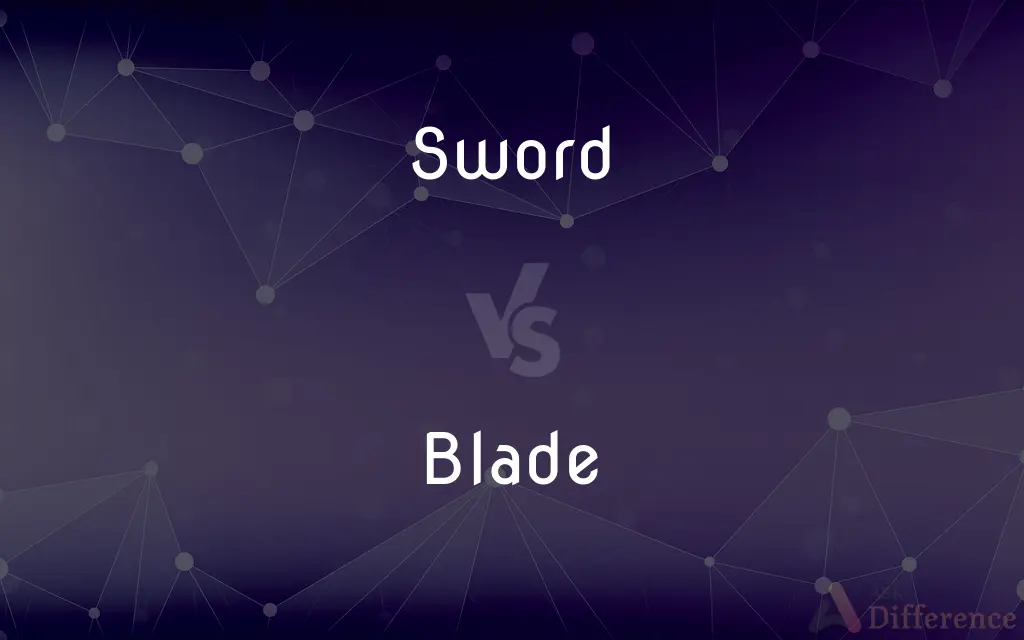Sword vs. Blade — What's the Difference?
By Maham Liaqat & Urooj Arif — Updated on March 28, 2024
A sword is a specific type of blade designed for thrusting and slicing, primarily used as a weapon, whereas a blade refers to any flat, cutting-edge part of a tool or weapon.

Difference Between Sword and Blade
Table of Contents
ADVERTISEMENT
Key Differences
A sword is a weapon with a long metal blade and a hilt, traditionally used for combat and ceremonial purposes. Blades, on the other hand, refer to the cutting edges of tools and weapons, including knives, swords, and axes. This means all swords are blades, but not all blades are swords.
Swords are characterized by their length, design for slashing or thrusting, and historical use in warfare and dueling. Blades, however, can vary widely in shape and size, designed for a multitude of purposes, from cooking and surgery to combat.
The design of a sword often includes specific elements like a guard, pommel, and sometimes a fuller for balance and weight reduction. Whereas blades may lack these features, focusing solely on the sharpness and durability of the cutting edge.
Swords have played a significant role in various cultures as symbols of power, honor, and justice. Blades, while also important, are more utilitarian in nature, serving functional roles across different tasks and industries.
While the maintenance of a sword involves careful polishing, sharpening, and sometimes oiling of the blade to preserve its integrity for combat, maintenance of other types of blades depends on their specific uses, materials, and required performance.
ADVERTISEMENT
Comparison Chart
Definition
A weapon with a long metal blade and a hilt.
The cutting edge of a tool or weapon.
Purpose
Primarily for combat and ceremonial uses.
Varied, including cutting, slicing, or as part of a weapon.
Components
Often includes a guard, pommel, and fuller.
May lack additional components beyond the cutting edge.
Symbolism
Associated with honor, power, and justice.
More utilitarian, without widespread symbolic significance.
Maintenance
Involves polishing, sharpening, and oiling.
Depends on the blade's use, material, and performance needs.
Compare with Definitions
Sword
Includes parts like the hilt, guard, and blade.
The sword's hilt was adorned with jewels, symbolizing status.
Blade
The cutting edge of a tool or weapon, flat and sharp.
The blade of the knife was sharp enough to slice through paper.
Sword
Requires regular sharpening and care to maintain effectiveness.
He spent hours sharpening his sword before the fight.
Blade
Found in various tools like knives, razors, and swords.
The chef's blade moved quickly through the vegetables.
Sword
Often symbolizes honor, power, and justice.
The sword was presented as a symbol of authority.
Blade
Can vary greatly in size, shape, and purpose.
The surgeon selected a small, precise blade for the operation.
Sword
A weapon with a long metal blade designed for slashing and thrusting.
The knight wielded his sword with skill in the duel.
Blade
Sharpness and integrity depend on material and use.
The blade needed to be replaced after extensive use.
Sword
Traditionally used in warfare, dueling, and ceremonies.
Swords were drawn as the battle commenced.
Blade
Lacks the widespread symbolic significance of swords.
The blade was a simple, yet essential tool for the craftsman.
Sword
A sword is an edged, bladed weapon intended for manual cutting or thrusting. Its blade, longer than a knife or dagger, is attached to a hilt and can be straight or curved.
Blade
A blade is the portion of a tool, weapon, or machine with an edge that is designed to puncture, chop, slice or scrape surfaces or materials. Blades are typically made from materials that are harder than those they are to be used on.
Sword
A handheld weapon consisting typically of a long, straight or slightly curved, pointed blade having one or two cutting edges and set into a hilt.
Blade
The flat cutting part of a sharpened weapon or tool.
Sword
The use of force, as in war.
Blade
A sword.
Sword
Military power or jurisdiction.
Blade
A swordsman.
Sword
(weaponry) A long-bladed weapon device with a grip- a hilt (a pommel and cross guard), which is designed to cut, stab, slash and/or hack.
Blade
(Archaeology) A slender, sharp-edged flake that is at least twice as long as it is wide.
Sword
(tarot) A suit in the minor arcana in tarot.
Blade
A dashing youth.
Sword
(tarot) A card of this suit.
Blade
A flat thin part or section, especially one that makes contact to perform a desired action
The blade of an oar.
The blade of a hockey stick.
Sword
(weaving) One of the end bars by which the lay of a hand loom is suspended.
Blade
An arm of a rotating mechanism
The blade of a propeller.
The blade of a food processor.
Sword
(heraldry) The weapon, often used as a heraldic charge.
Blade
A long, thin, often curved piece, as of metal or rubber, used for plowing, clearing, or wiping.
Sword
To stab or cut with a sword
Blade
The metal runner of an ice skate.
Sword
An offensive weapon, having a long and usually sharp-pointed blade with a cutting edge or edges. It is the general term, including the small sword, rapier, saber, scimiter, and many other varieties.
Blade
A wide flat bone or bony part.
Sword
Hence, the emblem of judicial vengeance or punishment, or of authority and power.
He [the ruler] beareth not the sword in vain.
She quits the balance, and resigns the sword.
Blade
The flat upper surface of the tongue just behind the tip.
Sword
Destruction by the sword, or in battle; war; dissension.
I came not to send peace, but a sword.
Blade
The expanded part of a leaf or petal.
Sword
The military power of a country.
He hath no more authority over the sword than over the law.
Blade
The leaf of grasses or similar plants.
Sword
One of the end bars by which the lay of a hand loom is suspended.
Blade
To skate on in-line skates.
Sword
A cutting or thrusting weapon with a long blade
Blade
The (typically sharp-edged) part of a knife, sword, razor, or other tool with which it cuts.
Blade
(metonymy) A sword or knife.
Blade
The flat functional end or piece of a propeller, oar, hockey stick, chisel, screwdriver, skate, etc.
Blade
The narrow leaf of a grass or cereal.
Blade
(botany) The thin, flat part of a plant leaf, attached to a stem (petiole). The lamina.
Blade
A flat bone, especially the shoulder blade.
Blade
A cut of beef from near the shoulder blade (part of the chuck).
Blade
The part of the tongue just behind the tip, used to make laminal consonants. Body parts
Blade
(archaeology) A piece of prepared, sharp-edged stone, often flint, at least twice as long as it is wide; a long flake of ground-edge stone or knapped vitreous stone.
Blade
(ultimate frisbee) A throw characterized by a tight parabolic trajectory due to a steep lateral attitude.
Blade
(sailing) The rudder, daggerboard, or centerboard of a vessel.
Blade
A bulldozer or surface-grading machine with mechanically adjustable blade that is nominally perpendicular to the forward motion of the vehicle.
Blade
(dated) A dashing young man.
Blade
Thin plate, foil.
Blade
(photography) One of a series of small plates that make up the aperture or the shutter of a camera.
Blade
The principal rafters of a roof.
Blade
(biology) The four large shell plates on the sides, and the five large ones of the middle, of the carapace of the sea turtle, which yield the best tortoise shell.
Blade
(computing) A blade server.
Blade
(climbing) knifeblade
Blade
(mathematics) An exterior product of vectors. (The product may have more than two factors. Also, a scalar counts as a 0-blade, a vector as a 1-blade; an exterior product of k vectors may be called a k-blade.)
Blade
The part of a key that is inserted into the lock.
Blade
An artificial foot used by amputee athletes, shaped like an upside-down interrogation mark.
Blade
(informal) To skate on rollerblades.
Blade
(transitive) To furnish with a blade.
Blade
To put forth or have a blade.
Blade
(transitive) To stab with a blade
Blade
To cut (a person) so as to provoke bleeding.
Blade
Properly, the leaf, or flat part of the leaf, of any plant, especially of gramineous plants. The term is sometimes applied to the spire of grasses.
The crimson dulse . . . with its waving blade.
First the blade, then ear, after that the full corn in the ear.
Blade
The cutting part of an instrument; as, the blade of a knife or a sword.
Blade
The broad part of an oar; also, one of the projecting arms of a screw propeller.
Blade
The scapula or shoulder blade.
Blade
The principal rafters of a roof.
Blade
The four large shell plates on the sides, and the five large ones of the middle, of the carapace of the sea turtle, which yield the best tortoise shell.
Blade
A sharp-witted, dashing, wild, or reckless, fellow; - a word of somewhat indefinite meaning.
He saw a turnkey in a triceFetter a troublesome blade.
Blade
The flat part of the tongue immediately behind the tip, or point.
"Lower blade" implies, of course, the lower instead of the upper surface of the tongue.
Blade
To furnish with a blade.
Blade
To put forth or have a blade.
As sweet a plant, as fair a flower, is fadedAs ever in the Muses' garden bladed.
Blade
Especially a leaf of grass or the broad portion of a leaf as distinct from the petiole
Blade
A dashing young man;
Gay young blades bragged of their amorous adventures
Blade
Something long and thin resembling a blade of grass;
A blade of lint on his suit
Blade
A cutting or thrusting weapon with a long blade
Blade
A cut of beef from the shoulder blade
Blade
A broad flat body part (as of the shoulder or tongue)
Blade
The part of the skate that slides on the ice
Blade
Flat surface that rotates and pushes against air or water
Blade
The flat part of a tool or weapon that (usually) has a cutting edge
Common Curiosities
What is a sword?
A sword is a weapon with a long metal blade and a hilt, used for combat and ceremonial purposes.
What distinguishes a sword from other types of blades?
Swords are distinguished by their length, design for slashing or thrusting, and ceremonial use.
Can a blade be part of a tool other than a weapon?
Yes, blades can be part of various tools, including kitchen knives and surgical instruments.
How is a blade maintained?
Blade maintenance varies, involving sharpening, polishing, and sometimes replacing, depending on its use and material.
What is a blade?
A blade is the cutting edge part of a tool or weapon, such as knives or swords.
Are all swords considered blades?
Yes, all swords are considered blades due to their cutting edges.
Do swords have symbolic meanings?
Yes, swords often symbolize honor, power, and justice in various cultures.
What role do blades play in everyday life?
Blades are essential in various tasks, from cooking and crafting to medical procedures.
Is the blade of a sword different from a kitchen knife's blade?
Yes, the blade of a sword is typically longer and designed for combat, whereas a kitchen knife's blade is designed for cutting food.
What are the main components of a sword?
The main components include the blade, hilt, guard, and sometimes a pommel and fuller.
Why are swords important in history?
Swords are important for their role in warfare, their symbolic meanings, and their influence on culture and art.
How do the purposes of swords and blades differ?
Swords are primarily used for combat and ceremonies, while blades serve a broader range of utilitarian purposes.
How has the design of swords evolved over time?
The design of swords has evolved to meet changing combat styles, technologies, and materials.
Can the term "blade" refer to non-metal objects?
While typically metal, "blade" can refer to any thin, sharp-edged part of a tool, including those made from ceramics or plastics.
Are there different types of blades depending on their usage?
Yes, there are many types of blades designed for specific tasks, ranging from precision cutting to heavy-duty chopping.
Share Your Discovery

Previous Comparison
Wiltshire vs. Hampshire
Next Comparison
Hibernate vs. StandbyAuthor Spotlight
Written by
Maham LiaqatCo-written by
Urooj ArifUrooj is a skilled content writer at Ask Difference, known for her exceptional ability to simplify complex topics into engaging and informative content. With a passion for research and a flair for clear, concise writing, she consistently delivers articles that resonate with our diverse audience.














































